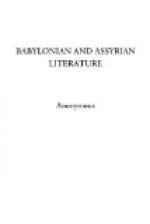This monument is now kept since 1801 in the “Cabinet des Medailles” at Paris (No. 702). Since that epoch it has always attracted the attention of scholars; it was published by M. Millin in 1802, “Monuments inedits” t. I, pl. viii, ix. Muenter first attempted to explain the symbolical figures ("Religion der Babylonier," p. 102, pl. III). Sir Henry Rawlinson has also published the inscription again, in “W.A.I.,” Vol. I, p. 70. The sense of this text has been fixed for the first time, in 1856, by M. Oppert’s translation in the “Bulletin Archeologique de l’Atheneum Francais” After this translation, Mr. Fox Talbot gave one in 1861, in the “Transactions of the Royal Asiatic Society,” Vol. XVIII, p. 54.
COLUMN I
20 hin of corn is the quantity for seeding an arura.[1] The field is situated near the town of Kar-Nabu, on the bank of the river Mekaldan, depending of the property of Kilnamandu.
The field is measured as follows:[2] Three stades in length toward the East, in the direction of the town of Bagdad; three stades in length toward the West, adjoining the house of Tunamissah; 1 stade 50 fathoms[3] in breadth toward the North, adjoining the property of Kilnamandu; 1 stade 50 fathoms up in the South, adjoining the property of Kilnamandu.
Sirusur, son of Kilnamandu, gave it for all future days to Dur-Sarginaiti, his daughter, the bride[4] of Tab-asap-Marduk, son of Ina-e-saggatu-irbu (the pretended), who wrote this; and Tab-asap-Marduk, son of Ina-e-saggatu-irbu, who wrote this in order to perpetuate without interruption the memory of this gift, and commemorated on this stone the will of the great gods and the god Serah.
[Footnote 1: Or the great U, namely, of the field in question.]
[Footnote 2: Dr. Oppert’s first translation of this passage, which is to be found in almost all documents of this kind, has been corrected in “L’Etalon des mesures assyriennes,” p. 42. The field of Kilnamandu was a rectangle of 1-5/6 stades in breadth and 3 stades long, viz., 5-1/2 square stades, amounting to 19.64 hectares, or 48-1/2 English acres. The Stone of Micheux is the only one which affords a valuation of the land.




